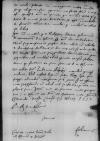15 huius allatae sunt huc litterae a Dominatione Vestra Reverendissima. Eas reddidit ⌊dominus zupparius⌋ ⌊maiestati regiae⌋, tunc in conclavi ⌊maiestatis reginalis⌋ exsistenti, sed maiestas regia suas non aperuit, saltem regina ad se scriptas legit. Fuit tunc prima hora noctis dataque est copia litterarum ⌊regis Angliae⌋ ad ⌊summum pontificem⌋ [eidem] domino zup[pa]rio on the margin⌈eidem hidden by binding⌈[eidem]eidem hidden by binding⌉ ⌊domino zuppa hidden by binding⌈[pa]pa hidden by binding⌉rio⌋[eidem] domino zup[pa]rio on the margin⌉, ut legeret cum responso papae hocque magis placuit. Post hanc lectionem fuit hora cenae, quare ⌊maiestas regia⌋ cum suis written over o⌈oisis written over o⌉ litteris abiit. Cumque vidisset ⌊maiestas reginalis⌋ et mihi litteras a Dominatione Vestra per ⌊dominum zupparium⌋ reddi, quaesivit post paululum, quidnam in eis scriptum esse<t>. Respondi pauca dedique, ut legeret. Fuit contenta, nam nihil in eis, prout nec umquam in aliis, reprehensibile fuit. Saltem in hoc uno viam mihi praeclusit, ubi Dominatio Vestra Reverendissima scribit et mihi iniungit, ut unum ex illis exemplaribus ⌊⌋ mittam reverendissimo ⌊domino Plocensi⌋. „Ego”, inquit, „mittam illi, non tu”, voluitque in praefatis Epitaphiis iudicium ⌊senis illius Siculi⌋ experiri, qui cum de superinscribed⌈dede superinscribed⌉ eis votum suum diceret et multis ambagibus damnaret, remissus est a quibusdam non indoctis etc. ad grammaticam, cum in ea doctior aestimatur quam in versibus.
Dominus etiam ⌊Tarlo canonicus⌋ me rogavit, ut unum exemplum exemplar eorum darem illi commodato, ut legeret tantum, cumque restitueret, laudavit inventionem hortatusque est me, ut hic impressori darem imprimenda,
 BCz, 1595, p. 400
BCz, 1595, p. 400
Quare loquar cum impressore mihi bene noto hidden by binding⌈[to]to hidden by binding⌉. Si volet, dabo, ut imprimat etc.
Hodie ⌊maiestas reginalis⌋ locuta est mecum de praesentium missione, dicens se Dominationi Vestrae Reverendissimae velle scribere de domino ⌊Cornelio Duplicio⌋, damnans quodammodo consilium Dominationis Vestrae Reverendissimae de eo in locum eiusdem substituen hidden by binding⌈[uen]uen hidden by binding⌉do, allegans abitionem eius in ⌊Subaudiam⌋.
Nuper excessit e vivis ⌊capitaneus Samogitiae⌋, homo hidden by binding⌈[o]o hidden by binding⌉ iuvenis, sed multis exosus et ingratus.
Item domina Sondeczka, matrona senex, eum secuta, reliquit domino Tarlo incisori, qui filiam ipsius Czenski Jan habet, multa bona.
Adventum seu reditum Dominationis Vestrae Reverendissimae multi hic cum maximo gaudio exspectant, quorum aliquot me hidden by binding⌈[e]e hidden by binding⌉ rogant, ut si de certo reditus tempore scivero, illis dicere velim, volunt 3 vel 4 diebus obviam praevenire Dominationi Vestrae Reverendissimae.
Haec quae sequuntur, rediens a ⌊maiestate reginali⌋ scribo hidden by binding⌈[bo]bo hidden by binding⌉, quae paulo ante pro me miserat accepitque unum hidden by binding⌈[num]num hidden by binding⌉ de meis exemplaribus, quod cras hinc ⌊domino episcopo hidden by binding⌈[episcopo]episcopo hidden by binding⌉ Plocensi⌋ mitte written over a⌈aee written over a⌉t, dicens mihi, non sine risu: „Nescio hidden by binding⌈[escio]escio hidden by binding⌉, quid ⌊Siculus⌋ fecit, totum libellum illum ⌊⌋, quem illi legendum dedi, glossavit et alicubi in mar hidden by binding⌈[mar]mar hidden by binding⌉gine scripsit: ’Mentiris, mentiris, mentiris hidden by binding⌈[s]s hidden by binding⌉’”. Haec salvo honore Dominationis Vestrae Reverendissimae itero, solet enim ⌊bonus hidden by binding⌈[bonus]bonus hidden by binding⌉ senex⌋ omnia, quae legit, brisilio(!) cancellare, omnia, dico hidden by binding⌈[co]co hidden by binding⌉, hoc est lineas omnes, nec versus solum, sed et solu hidden by binding⌈[solu]solu hidden by binding⌉ BCz, 1595, p. 401ta verba, praeterea in margine notat multa semper ubique. Causam ignoro, ne forte se<n>ium in causa est. Excessit enim, ut opinor, 90 annum, solet quoque dicere de annis suis, dictitans se esse immortalem et ferreum. Mirantur multi, quod multum comedat et bibat.
BCz, 1595, p. 401ta verba, praeterea in margine notat multa semper ubique. Causam ignoro, ne forte se<n>ium in causa est. Excessit enim, ut opinor, 90 annum, solet quoque dicere de annis suis, dictitans se esse immortalem et ferreum. Mirantur multi, quod multum comedat et bibat.
Hoc non omittam, quod dominus ⌊Nibschicz⌋ laetatur plurimum de revocatione Dominationis Vestrae Reverendissimae, semper enim lamentabatur: „Utinam supervsivere possem diem illum, cum redibit ⌊dominus Dantiscus⌋”, dubitans se diu victurum, sed volente Deo diu vivet. Hic me singulari benevolentia prosequitur ob nullam aliam, opinor, causam, saltem eam, quod fuerim et sim servus Dominationis Vestrae Reverendissimae.
De reditu domini ⌊Ludovici Aliphii⌋ nondum quicquam audivi. Nil restat dignum scitu neque haec, quae scripsi, admodum necessaria sunt scire, sed ut officio meo satisfaciam, cum aliud nihil se obtulit, praesentia complexus sum. Iterum me et servitia mea perpetua Dominationi Vestrae Reverendissimae, uti domino et patrono meo, humiliter commendo.
 BCz, 1595, p. 401ta verba, praeterea in margine notat multa semper ubique. Causam ignoro, ne forte se<n>ium in causa est. Excessit enim, ut opinor, 90 annum, solet quoque dicere de annis suis, dictitans se esse immortalem et ferreum. Mirantur multi, quod multum comedat et bibat.
BCz, 1595, p. 401ta verba, praeterea in margine notat multa semper ubique. Causam ignoro, ne forte se<n>ium in causa est. Excessit enim, ut opinor, 90 annum, solet quoque dicere de annis suis, dictitans se esse immortalem et ferreum. Mirantur multi, quod multum comedat et bibat.



